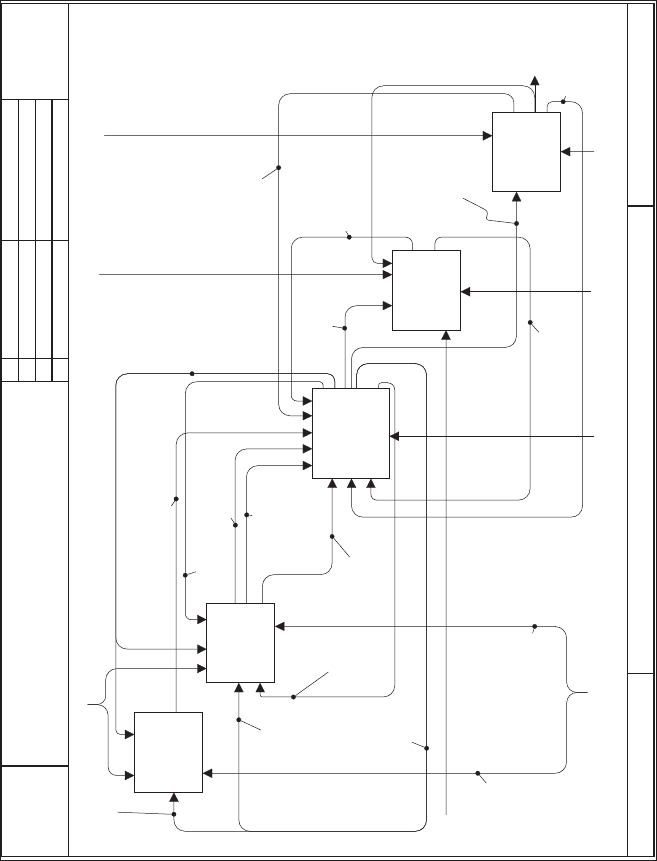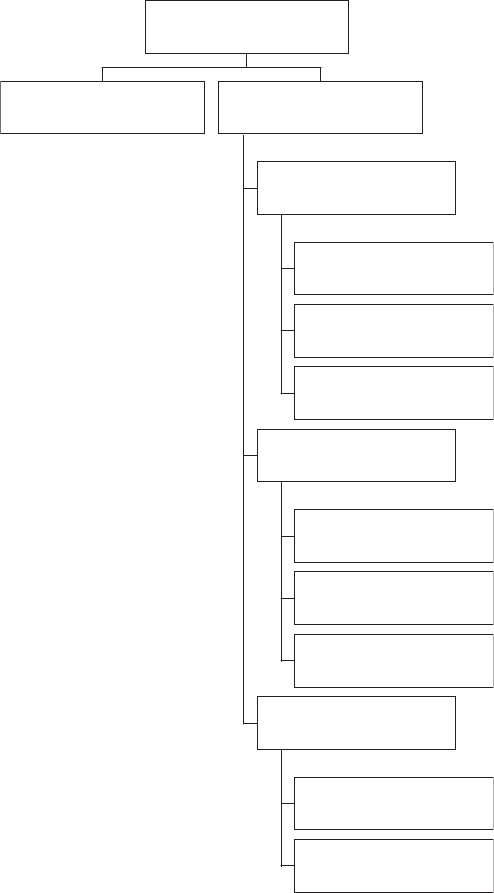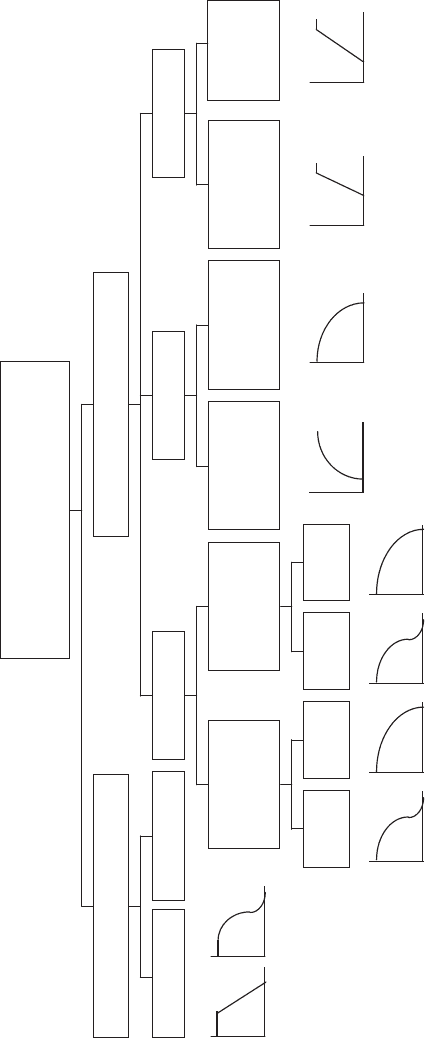Buede D.M. The Engineering Design of Systems Models and Methods
Подождите немного. Документ загружается.


USED AT:
CONTEXT:
NODE: TITLE: External Systems Diagram for Operational Phase NUMBER:
AUTHOR: Dennis Buede
PROJECT: Elevator Case Study
NOTES: 1 2 3 4 5 6 7 8 9 10
DATE: 05/24/99
REV:
WORKING
DRAFT
RECOMMENDED
PUBLICATION
READER DATE
P. 1
Provide
Elevator
Services
A-0
Passenger
Characteristics
Electric Power
& Emergency
Communication
Response
Service, Tests
& Repairs
Request for
Emergency
Support &
Emergency
Message
Request for
Floor & Exit
Support
Request for
Elevator
Service &
Entry support
Building
Regulations
Structural
Support,
Alarm Signals
& Building
Environment
ModifiedElevator
Configuration&
Expected
Usage Patterns
Passenger
Environment
Acknowledgment
that Request Was
Recieved & Status
Information
Diagnostic &
Status Messages
Elevator Entry
Opportunity
Elevator Exit
Opportunity
Emergency
Support
Request
Elevator
Services
A-11
Use
Elevator
Services
A-12
Maintain
Elevator
Operations
A-13
Provide
Structural
Support
A-14
Passengers' Needs
Emergency
Messages
Emergency
Communication
Passengers
Elevator System
Maintenance Personnel
Building
Passengers
Needing
Elevator
Services
Passengers
in Elevator
System
Repair
Parts
Elevator
Entry/Exit
Opportunity
Maintenance
Quality Standards
None
x
George Mason
Univ.
A-1
FIGURE 6.8 External systems’ diagram for operational use of an elevator.
181
6.12 OBJECTIVES HIERARCHY FOR PERFORMANCE REQUIREMENTS
Traditionally, systems engineers have used the terms measure of effectiveness
(MOE) and measure of performance (MOP), some times called a figure of merit
(FOM). A measure of effectiveness describes how well a system carries out a
task or set of tasks within a specific context; an MOE is measured outside the
system for a defined environment and state of the context variables and is used
to define mission requirements. Note that the further outsid e the system that
the MOE measurement process is established, the more influence the external
systems have on the measurement, yielding less sensitivity in the measurement
process for evaluating the effectiveness of the system. The MOE or MOEs that
were used to define the mission requirements can be divided into additional
MOEs for a given system, often one for each major output of the system.
An MOP (or FOM) describes a specific system property or attribute for a
given environm ent and context; an MOP is measured within the system. There
are many possible and relevant MOPs for a specific system output; examples
include accuracy, timeliness, distance, throughput, workload, and time to
complete. Usually only a few of these MOPs matter for each output. The
MOPs form the basis of stakeholders’ requirements when they address outputs.
The MOPs that address the performance of system components [e.g., chip
speed of the central processing unit (CPU)] are completely inappropriate for
use as requirements because they address how to achieve the stakeholders’
needs, not how well to meet these needs.
Since the systems engineering design process is decision rich, introducing
some concepts from decision analysis is important. Value-focused thinking
[Keeney, 1992] emphasizes the proper structuring of decisions in terms of a
fundamental objective. The fundamental objective is the aggregation of the
essential set of objectives that summarizes the current decision context and is
yet relevant to the evaluation of the options under co nsideration. Generally,
this fundamental objective can be subdivided into value objectives that more
meaningfully define the fundamental objective, thereby forming a fundamental
objectives hierarchy or value structure. Keeney [1992] distinguishes this hier-
archy from a means–ends objectives network, which relates means or ‘‘how to’’
variables (the design options and context) to the fundamental objective.
The objectives hierarchy of a system is the hierarchy of objectives that are
important to the system’s stakeholders in a value sense; that is, the stakeholders
would (should) be willing to pay to obtain increased performance (or decreased
cost) in any one of these objectives. Means objectives should not be part of this
objectives hierarchy. These means objectives describe physical ways to achieve
improvements in the fundamental objectives. Means objectives often contain
the variables used in simulation models to estimate the system’s performance
on the fundamental objectives. If there is some scientific relationship among a
set of variables in the objectives hierarchy , then these objectives are very likely
(but not definitely) means objectives and should be removed. Carrying the
decomposition of the fundamental objectives too far is a mistake.
182 REQUIREMENTS AND DEFINING THE DESIGN PROBLEM
The process that Keeney [1992] describes for defining this situation-based
fundamental objectives hierarchy is consistent with INCOSE Pragmatic
Principle 2 (as shown in italics) and involves working from both ends, by
generalizing means–ends objectives and operationalizing strategic objectives.
Means–ends objectives are ways to achieve the fundamental objective. Stra-
tegic objectives are beyond the time horizon and immediate control of options
associated with the current system design decision situation. As an example,
one of the set of fundamental objectives for the operation of a new elevator
(see Fig. 6.9) would be ‘‘minimize passenger time in the system.’’ The set
of fundamental objectives define value trade offs among the stakeholders
of the elevator system. A strategic objective would be to ‘‘improve the work-
ing environment in the building’’; there are too many other factors beyond
the elevator that will determine whether this objective is met for the objective
to be a fundamental objective. A means–ends objective would be to ‘‘use a
fuzzy logic controller’’; this statement addresses a means for a chieving an
objective.
Next, the fundamental objectives hierarchy is developed by defining the
natural subsets of the fundamental objective. Keeney gives the following
example of a fundamental objectives hierarchy: maximize safety (the funda-
mental objective) is disaggregated into minimize loss of life, minimize serious
injuries, and minimize minor injuries. The trade offs among these objectives
clearly entail one’s values, and only one’s values. This subdivision is contrasted
with a means–ends breakout of maximize safety that starts with minimize
accidents and maximize the use of safety features on vehicles, both of which are
means oriented and involve outcomes for which value trade offs are difficult.
Figure 6.9 provides the fundamental objectives hierarchy for the operation of
the elevator.
Pragmatic Principle 2 [DeFoe, 1993] Use Effectiven ess Criteria Based on
Needs to Make System Decisions
1. Select criteria that hav e demonstrable links to customer/consumer needs
and system requirements.
a. Operational criteria: mission success, technical performance
b. Program criteria: cost, schedule, quality, risk
c. Integrated logistics support (ILS) criteria: failure rate, maintainability,
serviceability
2. Maintain a ‘‘need-based’’ balance among the often-conflicting criteria.
3. Select criteria that are measurable (objective and quantifiable) and
express them in well- known, easily understood units. However, important
criteria for which no measure seems to exist still must be explicitly
addressed.
4. Use trade offs to show the customer the performance, cost, schedule, and
risk impacts of requireme nts and solutions variations.
6.12 OBJECTIVES HIERARCHY FOR PERFORMANCE REQUIREMENTS 183

5. Whenever possible, use simulation and experimental design to perform trade
offs as methods that rely heavily on ‘‘en gineering judgment’’ rating scales
are more subject to bias and error.
6. Have the customer make all value judgments in trade offs.
Monthly Operating Costs
$1,500 - $1,000, Wt = 0.1
Average Wait (Routine)
35 - 27 sec, Wt = 0.3
Average Wait (Priority)
35 - 30 sec, Wt = 0.35
Average Transit Time
90 - 60 sec, Wt = 0.35
Time in System
Objectives, Wt = 0.35
Max'm Acceleration
1.5 - 1.25 m/s2, Wt = 0.3
Max'm Accel'n Change
2 - 1.5 m/s3, Wt = 0.5
Floor Leveling Error
0.7 - 0.3 cm., Wt = 0.2
Ride Quality
Objectives, Wt = 0.30
Operational MTBF
1 - 1.5 yrs, Wt = 0.5
Operational MTTR
8 - 4 hrs, Wt = 0.5
Availability
Objectives, Wt = 0.35
Operational Performance
Objectives, Wt = 0.9
Operational
Objectives
FIGURE 6.9 Fundamental objectives hierarchy for operational phase of elevator.
184
REQUIREMENTS AND DEFINING THE DESIGN PROBLEM
7. Allow the customer to modify requi rements and participate in developing the
solution based on the trade offs.
The objectives hierarchy (a directed tree) usually has two to five levels. The
objectives in the hierarchy may include stakeholders explicitly and often include
context (environmental) variables (e.g., weather conditions, peak versus non-
peak loading) from the scenarios in the operational concept. If present, these
scenarios are usually at the top of the hierarchy, shown as varying conditions
for defining the objectives.
To make use of the objectives hierarchy for trade studies, additional
information must be added; value curves must be added for each objective at
the bottom of the objectives hierarchy and value weights for comparing the
relative value of swinging from the bottom of each value scale to top. Figure 6.9
shows the thresholds and design goals for each objective; each threshold a nd
design goal defines a ‘‘swing’’ in performance that is used to establish the
‘‘swing’’ weights in the value model (see Chapter 13). Figure 6.10 illustrates the
value curves for a simplified objectives hierarch y for an elevator system. See
Sailor [1990] for another example.
As mentioned above, decision analysis uses value curves and weights to
support trade-off decisions. These value curves and weights need to be obtained
from the stakeholders for two important reasons. First, the objectives typically
span several groups of stakehol ders, necessitating an agreement among these
groups of stakeholders about the relative importance of one objective with
others. Second, this objectives hierarchy and its associated value curves and
weights represent the value structure needed by the systems engineering team to
make many trade-off decisions during the design process. The values are those
of the stakeholders, not the systems engineers. Far too often the systems
engineers must guess at the stakeholders’ values during design decisions, or
even worse, are not even aware that design decisions have impacts on the
ultimate satisfaction the stakeholders will experience.
The objectives hierarchy is typically used throughout the systems engineering
design process as the cornerstone of all of the trade studies that compare one
design alternative with another. In doing trade studies the evaluation should
reveal which of several design alternatives is preferred; each design alternative
will commonly have one advantage over the others, such as operational cost,
reliability, accuracy of outputs, and the like. Since there is a system and
associated qualification system for each phase of the life cycle, there should also
be an objectives hierarchy for each of these systems.
This decision analysis approach has been used for many military acquisi-
tions, two of which are covered in Buede and Bresnick [2007], in which the
objectives hierarchy, value curves, and weights were developed with govern-
ment users and included in the request for proposal (RFP) to industry; Chapter
13 provides a discussion of one of these two acquisitions. This explicit,
quantitative approach received very positive responses from the industry design
teams. Watson and Buede [1987] describe the analytic methodology that was
6.12 OBJECTIVES HIERARCHY FOR PERFORMANCE REQUIREMENTS 185

Development
Operating
Costs
Non-Peak
Periods
Non-Peak
Periods
Average 95th Percentile
Waiting Time
Maximum
Acceleration
Floor
Leveling
Error
Ride Quality
Peak
Periods
Peak
Periods
Peak
Periods
Non-Peak
Periods
Availability
Fundamental Objectives
of Elevator System
secs. secs. secs. secs.
$
Value
$
Value
Value
Value Value Value Value
Value Value Value
m/sec
2
cm. hrs. hrs.
Operational Effectiveness
FIGURE 6.10 Objectives hierarchy with value curves.
186
used for these efforts. Other applications include Sailor [1990], Thurston and
Carnahan [1993], and Walters [1994].
6.13 PROTOTYPING, ANALYSES AND USABILITY TESTING
Prototyping can apply to any aspect of the system and is synonymous with
modeling. A prototype is a physical model of the system that ignores certain
aspects of the system, glosses over other aspects, and is fairly representative of a
third segment of aspects of the syst em. The prototype can range from a subscale
model of the system to a paper displ ay (storyboard) of the user interface of the
system. Prototyping became strongly associated with software development in
the 1980s, and it is this context that will be the focus of this section. Most
discussions of prototyping focus on the development of the prototype and
assume that the answers for requirements and design alternatives magically
appear. However, in the real world the prototype has to undergo usability
testing in order for this information to be gathered reliably.
The development of a prototype for a user interface ranges from a throw-
away prototype to an evolutionary prototype [Connell and Shafer, 1989].
Throwaway prototypes are just what the name implies, prototypes that are
developed for the main purpose of educating the users about the possibilities
and extracting requirements from the users based upon their needs. Evolu-
tionary prototype s are built for these educational and requirements develop-
ment purposes as well, but with the idea that the prototype will eventually be
turned into a working version of the system. The evolutionary prototype
initially will only address a portion of the total functionality of the system, and
that new functionality will be added on as the development and ope rational
phases evolve together. Both of these concepts of prototyping have proven
effective and continue today. In fact, software products for the rapid develop-
ment of prototypes are now a business area in their own right.
In Chapter 9 we will introduce many types of analyses that should be
conducted as part of the process for engineering systems. These analyses range
from performance analyses to predict how far or well the system might be able
to travel or see; timing analyses to determine how fast the system can respond
or how many outputs the system can deliver per unit time; and ‘‘-ility’’ analyses
to determine how available or safe the system is. There are also many cost and
schedule analyses conducted. During the requirements phase these analyses
should be conducted on the meta-system to determine what difference is made
in the performance, cost, and schedule parameters of the meta-system as the
performance, cost, and schedule of the system being engineered are varied. The
results of these an alyses provide very important information for the setting
of minimum acceptable and desired marks in the system’ s requirements’
statements.
Coupled with these analyses are many forms of elicitation of the viewpoints
of the stakeholders. These elicitation sessions can be interviews with one or a
6.13 PROTOTYPING, ANALYSES AND USABILITY TESTING 187

few stakeholders, facilitated group sessions, observations of stakeholder
performance on the current system or with prototypes of the new system,
and questionnaires. Questionnaires are the last resort when no other approach
is available since questionnaires produce lots of random responses from
stakeholders that were too busy or too confused to do better. Valuable
information is usually only achieved through human interactions. Individual
interviews are best at soliciting information from quiet people who might be
silent during group sessions. Facilitat ed meetings are best used to surface
disagreements and try to find common ground or reasons for the differences of
opinion that trace back to context and external system interactions. Observa-
tions are best for stressful periods during which people do things that they may
not consciously recall during discussions.
Usability testing is the process of obtaining samples of users and eliciting the
reactions of these users about their needs and desires as they interact with
prototypes. The prototypes can be as crude as written samples of screen
interfaces or as sophisticated as working modules of the system. Usability [Bias
and Mayhew, 1994; Nielsen, 1993; Wiklund, 1994] is a discipline associated
with human-computer interaction that became very sophisticated in the 1980s
and 1990s.
The performance elements of usability are ease of learning (learnability),
ease of use (efficiency), ease of remembering (memorability), error rate, and
subjectively pleasing (satisfaction). Table 6.5 provides a sample of common
metrics for each of these elements. Each of these metrics has to be measured in
the context of specific types of users and specific tasks. The tasks come from the
scenarios in the operational concept. For the error rate element, categorizing
errors into categories such as minor, major, and catastrophic is important. Care
must be taken to separate random errors from those caused by the system. If
necessary, baselin e capabilities of the users must be measured in order to define
a baseline error rate for categories of users. Satisfaction typically has to be
measured by subjective, categorical questions; see Nielsen [1993].
TABLE 6.5 Metrics for Measuring Usability Elements
Usability
Element
Metrics
Learnability Time to master a defined efficiency level, e.g., 50 words per minute
Time to master a defined skill, e.g., cut and paste
Efficiency Time for a frequent user to complete a defined task
Rate of producing a defined set of products for a frequent user
Memorability Time for a casual user to complete a defined task
Time for a casual user to achieve previously achieved rate of
production
Error Rate Number of errors of a specific type in a given period for a given task
Satisfaction Stress level associated with use
Fun level associated with use
188
REQUIREMENTS AND DEFINING THE DESIGN PROBLEM
Users can be categorized along three dimensions: domain knowledge,
computer experience, and system use experience. Segments of users along these
three dimensions should be developed for testing purposes. When a sample of
users is developed for the usability testing, the population of actual system
users must be considered, not the population of people in society.
Many guidelines have been developed for user interfaces. There is insuffi-
cient room to even summarize these guidelines here, but they should be
consulted while developing requirements for user interfaces [see Brown
1988; Chapanis 1996; Marshall et al., 1987; Mayhew, 1992; Reason, 1990;
Shneiderman, 1992].
6.14 DEFINING THE STAKEHOLDERS’ REQUIREMENTS
The framework for defining requirements on the basis of the operational
concept, the external system diagra m, and the objectives hierarchy is presented
here in detail. Recall that there are four requirements categories: input/output,
system-wide and technology, trade-off, and qualification. The addendum,
which can be downloaded from the author’s web site, (http://www.theengi-
neeringdesignofsyst ems.com) provides a detailed example of these requirements
for the life-cycle phases of an elevator.
6.14.1 Input/Output Requirements
Input/output requirements are defined on the basis of the inputs, controls, and
outputs of the system identified while boundi ng the system with the external
systems diagram. This external systems diagram is the primary tool used to
support the development of input/output requirements.
The systems engineering team must examine each input, control, and output in
detail to discover every requirement associated with each of these items. One or
more input requirements are written for each input and control; similarly, one
or more output requirements are written for each output. For example, the
potential passengers of the elevator have certain characteristics that impact
the provision of information about the floor location of the elevator. The
requirements should state that audible feedback is needed, but this would be
wrong. Rather the requirements should dicta te that feedback be provided to all
relevant passengers, letting the engineers design a syst em to do this.
See Table 6.2 for examples of requirements that may be associated with
inputs or outputs. Note there will be some controls such as policies and
procedures that were included because each function requires at least one
control. These controls are not really data elements that the system receives,
and therefore there need not be any input requirements established for them.
The environment (e.g., weather and elements that are outside the control of
the system) or ‘‘context’’ is typically defined as part of the scenarios of the
6.14 DEFINING THE STAKEHOLDERS’ REQUIREMENTS 189
operational concept. This context should be addressed in the requirements. The
questions typically addressed are:
1. What elements of the environment matter?
2. How much variation in the environmental elements must be planned for?
At what priority?
3. How well can these variations be forecasted (predicted)? Can these
forecasts be part of the system?
4. Can the environment be controlled by the system or external system?
Must the system protect itself from the environment?
In addition to input and output requirements there are external inter-
face constraints and the functions that should be used to decompose the
system’s function. Interface constraints address the physical aspects of
the interface to which the system has to connect to obtain the inputs an d
disseminate the outputs. Examples include the standar d connector type for
electrical and mechanical connections. The characteristics of the power or
data that come across the interface should be part of the input or output
requirement.
Finally, the functional req uirements are not meant to be a long list of
specific, detailed functions the system has to perform to produce outputs
needed by the system. Rather, the functional requirements should be the two to
six functions that partition the system function in such a way that all of the
inputs to the system can be transformed into all of the outputs that ha ve been
identified as part of the exter nal systems diagram.
Several examples of input/output requirements are:
The elevator shall receive ‘‘calls’’ from all floors of the building. (Input
requirement)
The elevator shall indicate to a prospective passenger that he/she has
successfully called the elevator. (Output requirement)
The elevator shall use a standard phone line from the building for emergency
calls. (External interface requirement)
6.14.2 System-Wide and Technology Requirements
The system-wide and technology requirements relate to the system as a whole
and not to specific inputs or outputs. These system-wide and technology
requirements are not represented in the external systems diagram and are not
addressed in a substantial way in the operational concept. Yet every system
should have several system-wide and technology requirements that are key to
the system’s success. Recall that the four major categories are technology,
suitability, cost, and schedule.
190 REQUIREMENTS AND DEFINING THE DESIGN PROBLEM
